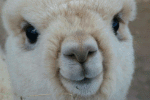Articles by Alpaca World Magazine:
Rickets and Angular Limb Deformities in Llamas and Alpacas
Claire E Whitehead BVM&S MS DACVIM MRCVS
Rickets is a common condition affecting South American Camelids residing outside of South America. It is a disease characterised by stunted growth, angular limb deformities and lameness: as such it is of important commercial significance to camelid breeders. The primary cause of rickets is believed to be a deficiency in vitamin D and is associated with hypophosphataemia1,2,6, or low blood phosphorus.
Rickets has been reported in many species including camelids1,2,3, sheep4 and humans. In camelids, it has been reported in North America1, New Zealand2, Australia3 and Europe. Rickets occurs most severely in growing animals and is characterised by a failure of mineralisation at the growth plates resulting in increased depth of the cartilaginous growth plates which become distorted due to the pressure of weight-bearing5. These changes are most obvious in sites where growth occurs rapidly such as in growth plates adjacent to the carpal and fetlock joints and the costochondral junctions of the ribs. This can be seen readily on radiographs (Figure 1). Changes can be identified clinically as swollen, painful joints and the classical rosary bead feel along the ribcage which reflects enlargement of the costochondral junctions. Angular limb deformities may subsequently develop and affected individuals show lethargy, will have depressed appetites, may be lame and walk with a hunched back due to pain and are typically smaller than age-matched herd mates. (Figure 2)
There are 2 sources of vitamin D for herbivorous animals including camelids. These are dietary vitamin D2 (ergocalciferol) available from plants and vitamin D3 (cholecalciferol) which is made in the skin by the action of U-V light on pro-vitamin D3. Dietary vitamin D2 is found in higher concentrations in mature grass or hay: spring grass is relatively low in vitamin D. Therefore Spring is a high risk time for Summer or Autumn born crias which may have been weaned over the winter and put out on fresh pastures with no supplementary feeding, assuming that Spring grass is sufficient. A seasonal variation in vitamin D3 has been described in llamas and alpacas6 and sheep7 where blood concentrations drop during the winter months due to reduced ultraviolet light availability. It is believed that reduced exposure to U-V radiation at reduced altitudes and non-equatorial latitudes (i.e. outside South America) causes reduced vitamin D activation in skin. It has also been suggested in sheep that increased pigmentation and amount of fleece result in reduced photobiosynthesis of vitamin D and that therefore darker unsheared animals are more susceptible to rickets7. Similar findings were found in alpacas by Smith and van Saun 6 and Judson and Feakes 2. Vitamin D may also be passed transplacentally or via the dam?s milk to neonates9. Vitamin D is actually a hormone and it is involved in the regulation of calcium and phosphorus concentrations in the body. In growing crias it ensures that there are enough of these minerals to allow growth.
It is advisable to supplement crias using injectable vitamin D containing products 2 or 3 times during the winter months. Current recommendations are to inject crias subcutaneously with preparations containing vitamin D (usually in vitamin AD&E mixtures) so that the dose of vitamin D is 1000 IU/kg body weight2. This is done twice during the winter, usually in November and February: the effects of the injection last 2-3 months. In some areas, 3 injections may be recommended, especially if the winter is prolonged. There are oral multivitamin formulations available but these require more frequent dosing (about every 6 weeks). The injectable form of vitamin D is no longer easily available in the UK but your vet can import it from Ireland with an import certificate.
Angular limb deformities (ALD) may be congenital or acquired. They can be conformational in origin (genetic), associated with joint instability in premature crias, due to trauma (in either the affected leg or the opposite one) or secondary to rickets. It is important to differentiate these so that the correct breeding choices are made. Severe deformities may result in abnormal weight-bearing, secondary subluxation of fetlocks, joint pain and arthritis later in life. Correction of angular limb deformities can be achieved but must not be used only to mask bad conformation.
Carpal valgus (?knock knees?) is the most commonly encountered ALD. Although hind limbs may also be affected, carpal valgus is more easily corrected. Premature crias with joint laxity may benefit from splint application if the angulation is severe enough to interfere with ambulation. These may be placed and maintained for 7-10 days. Radiographs should be taken in order to assess the severity of the deformity and to determine whether lesions consistent with rickets are present. The earlier the ALDs are treated, the less invasive the method of treatment can be with fewer subsequent complications.
If only a mild ALD is present in a young cria (<3 months old), injection of vitamin D at 1000-2000 IU/kg body weight may improve the deformity or be curative in cases where hypovitaminosis D is the cause. This can be confirmed by determination of serum vitamin D concentration. Where a more severe defect is present in a similarly aged cria, or a more aggressive approach is desired, surgery may be indicated in addition to vitamin D therapy. The least invasive technique and one that is appropriate at this stage is periosteal stripping. This procedure involves making a 5-6cm incision down to the bone on the outside surface of the front leg over the growth plate and then elevating the periosteum (the membrane that covers the surface of the bone). This causes the growth plate on this side to grow faster and so straighten out the defect. Re-evaluation should be done 30-45 days following surgery to assess adequacy of correction.
As the cria becomes older (>3 months) or if the ALD is severe (>10), more invasive surgery is required. At this point, transphyseal bridging of the radial growth plates can be done. This technique is effective in young animals that still have open growth plates and are still growing. In this case, the incision is made on the inside of the affected carpus. One screw is placed above and another placed below the growth plate, and wire is placed around the two screws in a figure 8 pattern. This stops the growth plate from growing on this side so that the other side can grow and straighten out the defect. It is vital that the cria is monitored closely so that screws can be removed just when the deformity has been corrected. This will normally be in 3-4 weeks. It is possible that one leg may correct more quickly than the other in bilateral cases in which case two separate anaesthetics will be required for screw removal. If screws are left in too long, a varus deformity (?bow legged conformation?) will result.
After 9 months of age, the radial growth plates have effectively closed and corrective osteotomy is required to correct an ALD. This essentially means that the long bones have to broken and put back together again but straighter. Clearly this procedure has a greater chance of failure and the potential for complications is far greater. This should be done if the animal?s quality of life will be affected by the deformity. The take-home point here is that prevention of rickets is far better than the cure.
Figure 1: A 4.5 month old cria displaying the classic hunched-up appearance consistent with rickets. He also weighs only 11kg.
Figure 2: Radiograph showing growth plate abnormalities in the radius of a 4 month old alpaca cria with rickets. Note the angle of deviation also.
Bibliography
1) Van Saun RJ, Smith BB, Watrous BJ. Evaluation of vitamin D status of llamas and alpacas with hypophosphataemic rickets. JAVMA, 1996;209:1128-33.
2) Judson GJ and Feakes A. Vitamin D doses for alpacas (Lama pacos). Australian Vet J. 1999;77:310-315.
3) Hill FI, Thompson KG, Grace ND. Rickets in alpacas (Lama pacos) in New Zealand. NZ Vet J 1994;42:229-32.
4) Bonniwell MA, Smith BSW, Spence JA, Wright H, Ferguson DAM. Rickets associated with vitamin D deficiency in young sheep. Veterinary Record 1988;122:386-388.
5) Palmer N. Bones and joints. In: Jubb KVF, Kennedy PC, Palmer N, eds. Pathology of Domestic Animals. 4th ed, vol 1, New York: Academic Press Inc, 1993: 67-72.
6) Smith BB, Van Saun RJ. Seasonal changes in serum calcium, phosphorus, and vitamin D concentrations in llamas and alpacas. Am J Vet Res 2001;62:1187-1193.
7) Smith BSW, Wright H. Relative contributions of diet and sunshine to the overall vitamin D status of the grazing ewe. Veterinary Record 1984;115:537-538.
8) Lal H, Pandey R, Aggarwal SK. Vitamin D: Non-skeletal actions and effects on growth. Nutr Research 1999;19:1683-1718.
9) Ross R, Care AD, Robinson JS, Pickard DW, Weatherley AJ. Perinatal 1,25-dihydroxycholecalciferol in the sheep and its role in the maintenance of the transplacental calcium gradient. J Endocrinology 1980;87:17-18.
Tweet



